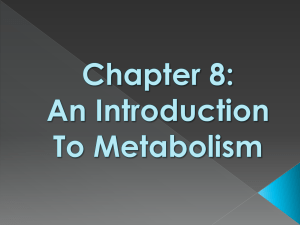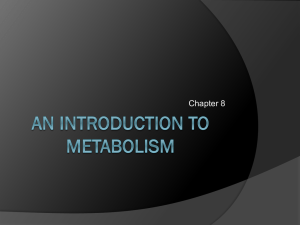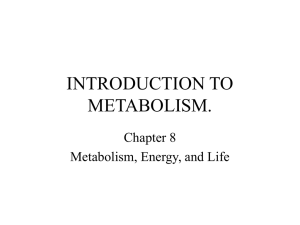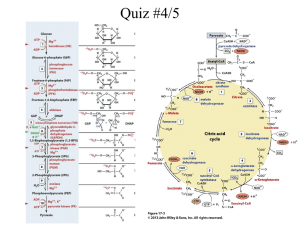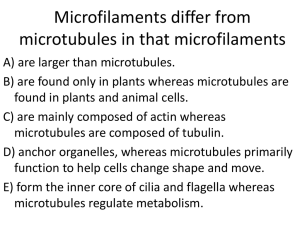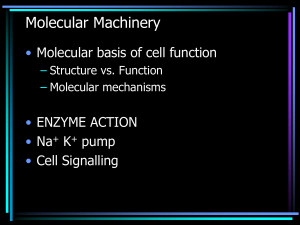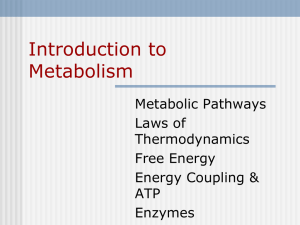Ch 8 - Metabolism (enzymes)
advertisement
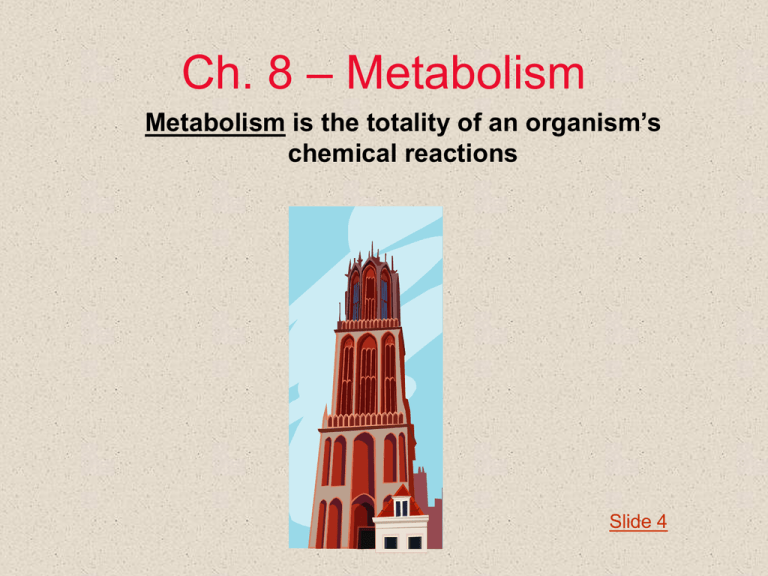
Ch. 8 – Metabolism Metabolism is the totality of an organism’s chemical reactions Slide 4 An Introduction to Metabolism I. Thermodynamics: The study of energy exchanges (transformations) A. First Law of Thermodynamics: Energy can not be created or destroyed. Energy is constant but can be transformed from one form to another B. Second Law of Thermodynamics: Any transfer of energy results in a loss of useable energy (heat/entropy/increasing disorder) Potential Energy Entropy “Energy always flows downhill” Kinetic Energy Energy Exchanges can be expressed by the equation: G = (Delta) H - T Slide 1 S = (Final State) - (Initial State) G = Free Energy Exchange/capacity to do work H = Amount of total energy available in the system T = Temperature S = Amount of Entropy (disorder / stability) Initial State: 1. More Free Energy in System (H) 2. Less stable / Lower Entropy (S) 3. Greater Work Capacity (G) Gravitational Motion Diffusion Molecular Motion Chemical Reactions + G - G - S Spontaneous Change 1. Free Energy Decreases 2. Increasing stability 3. Free energy released to do work Final State: 1. Less Free Energy in System (H) 2. More Stable / Higher Entropy (S) 3. Less Work Capacity (G) + S Bioenergetics: Energy Exchanges in Living Organisms 1. Energy Exchanges always involve interactions of Electrons 2. Energy is used/released as electrons rearrange in “new” shells AB + CD Metabolism Vocab Endergonic Exergonic AC + BD Spontaneous AC + BD AB + CD Non-spontaneous AB + CD AB + CD Energy Output AC + BD Energy Input AC + BD + G - G Increasing Entropy Decreasing Entropy Anabolic 1. Exergonic 1. Endergonic 2. Spontaneous 2. Non-Spontaneous 3. - 3. + 4. Increasing Entropy 4. Decreasing Entropy 5. Catabolic 5. Anabolic 6. Energy Released 6. Energy Required Cell Respiration 7. Cell Respiration 7. Photosynthesis Photosynthesis G G Catabolic Energy Released Energy Required Energy Coupling - The Link between Anabolism and Catabolism; using an exergonic process to drive an endergonic process 1. ATP is the “energy coupler” 2. The structure of ATP allows the transfer of a phosphate that will increase the energy level of molecules through the process of phosphorylation. P ADP ATP P - AC + BD AB + CD AC + BD Energy Required AB + CD Energy Required Place the words below on the appropriate side of the ATP ADP cycle Phosphate Added Exergonic Synthesis work Phosphate removed Transport work Anabolic + - G Hydrolysis Kinetic Energy Energy Poor Endergonic Chemical work Catabolic G Dehydration Synthesis Increasing Entropy Decreasing Entropy Potential Energy Energy Rich ADP Phosphorylated Other molecule phosphorylated ATP Phosphate Added Potential Energy Phosphate Removed Kinetic Energy Endergonic Anabolic Exergonic Energy Rich Energy Poor Catabolic ENERGY ENERGY Other Molecules Phosphorylated + G ADP Phosphorylated Transport Work - Dehydration synthesis G ADP Decreasing Entropy Hydrolysis Chemical Work Synthesis Work Increasing Entropy Examples of how ATP drives Transport and Mechanical Work ATP ADP Motor protein Slide 7 Enzymes: Proteins that make life possible 1. All chemical reactions need an energy push to start the reaction 2. Enzymes unique structure lowers the energy of activation Energy required without enzyme AB + CD Energy required with enzyme Total energy given off by reaction AC + BD Important Enzyme Concepts Substrate: The substance(s) Sucrase Substrate that is acted on by the enzyme (Sucrose) Product: The substance(s) that results from enzyme activity (Glucose + Fructose) Active Site: The part of the enzyme that Sucrose Enzyme- Substrate Complex bonds to the substrate Lock and Key Substrate and enzyme fit perfectly together H2O Induced Fit Important Enzyme Concepts Active Site 1. Enzymes are not used up in the reaction 2. Enzymes are specific for their substrates 3. Enzymes can be catabolic or anabolic Glucose 4. Enzymes are proteins. Their active sites can be denatured and be non-functional. (pH and temperature) Products Fructose 5. As Proteins, enzymes are coded by the DNA. Gene traits are due to the enzymes an organism makes Enzyme Inhibitors Normal Interaction Substrate Active Site Enzyme Competitive Inhibition Inhibitor fits into active site and “competes” with the real substrate [influenced by concentration of substrate] Inhibitor Non-Competitive Inhibition Inhibitor bonds to enzyme away from the active site; changes shape of active site (can be part of feedback inhibition) [not influenced by concentration of substrate] Inhibitor (Negative) Feedback Inhibition: End product switches off its own production Initial Substrate Active site no longer bonds to threonine Isoleucine fits in allosteric site or noncompetitive site (threonine) Intermediate A Enzyme 2 Intermediate B Enzyme 3 Intermediate C Enzyme 4 Intermediate D Enzyme 5 End Product Feedback Inhibition (isoleucine) *Many normal enzymes need non-protein ‘helpers’ to become active and function Cofactors – Bind to place other than active site; inorganic like zinc, iron, copper Coenzymes – Cofactors that are organic; vitamins like C, D, E Allosteric Enzymes: Contain allosteric sites that affect enzyme activity. Molecules bonding to the allosteric sites can activate or inhibit. Many allosteric enzymes are involved in negative feedback pathways Activator Inhibitor Active sites Active Form Inactive Form Cooperativity: As a substrate binds to an enzyme, the enzyme changes shape (induced fit) allowing other active sites to bind to the substrate Substrate Active site with greatest affinity to substrate New active sites are made available Inactive form Active form How Phosphorylation Transfers Energy Slide 5 The Structure and Function of ATP Structure Function Slide 5 1st Law of Thermodynamics 100 Energy Units Transformation #2 Transformation #1 Transformations aaa 100 Energy Units Slide 1 2nd Law of Thermodynamics 50 units 25 units 100 units 50 units 25 units Slide 1 A spontaneous chemical reaction will occur…but how long will it take? Sucrose (C12H22O11) Slide 9 Space-filling model of Active Site Slide 10 Environmental factors affecting enzyme activity Slide 10

